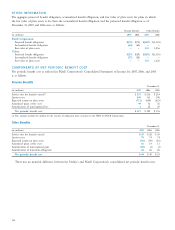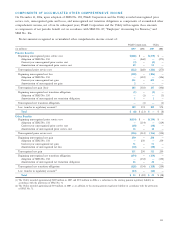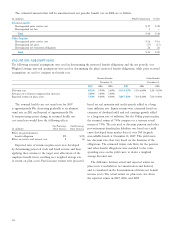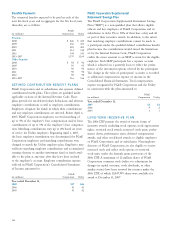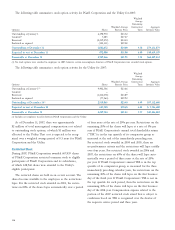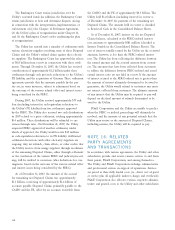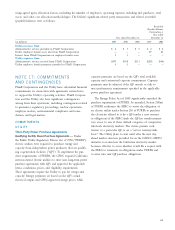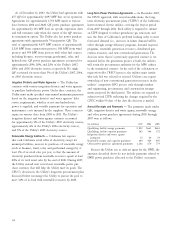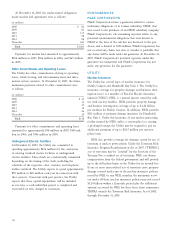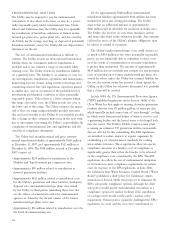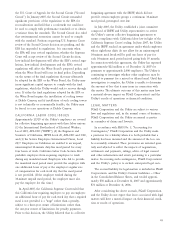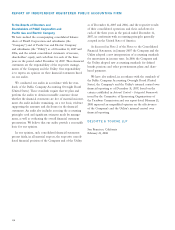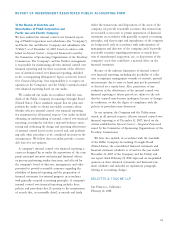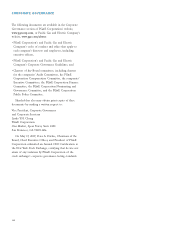PG&E 2007 Annual Report Download - page 132
Download and view the complete annual report
Please find page 132 of the 2007 PG&E annual report below. You can navigate through the pages in the report by either clicking on the pages listed below, or by using the keyword search tool below to find specific information within the annual report.
130
As of December 31, 2007, the Utility had agreements with
257 QFs for approximately 4,097 MW that are in operation.
Agreements for approximately 3,754 MW expire at various
dates between 2008 and 2028. QF power purchase agreements
for approximately 343 MW have no specifi c expiration dates
and will terminate only when the owner of the QF exercises
its termination option. The Utility also has power purchase
agreements with approximately 74 inoperative QFs. The
total of approximately 4,097 MW consists of approximately
2,524 MW from cogeneration projects, 580 MW from wind
projects and 994 MW from projects with other fuel sources,
including biomass, waste-to-energy, geothermal, solar, and
hydroelectric. QF power purchase agreements accounted for
approximately 20%, 20%, and 22% of the Utility’s 2007,
2006, and 2005 electricity sources, respectively. No single
QF accounted for more than 5% of the Utility’s 2007, 2006,
or 2005 electricity sources.
Irrigation Districts and Water Agencies — The Utility has
contracts with various irrigation districts and water agencies
to purchase hydroelectric power. Under these contracts, the
Utility must make specifi ed semi-annual minimum payments
based on the irrigation districts’ and water agencies’ debt
service requirements, whether or not any hydroelectric
power is supplied, and variable payments for operation and
maintenance costs incurred by the suppliers. These contracts
expire on various dates from 2008 to 2031. The Utility’s
irrigation district and water agency contracts accounted
for approximately 3% of the Utility’s 2007 electricity sources,
approximately 6% of the Utility’s 2006 electricity sources,
and 5% of the Utility’s 2005 electricity sources.
Renewable Energy Contracts — California law requires
that each California retail seller of electricity, except for
municipal utilities, increase its purchases of renewable energy
(such as biomass, wind, solar, and geothermal energy) by at
least 1% of its retail sales per year, so that the amount of
electricity purchased from renewable resources equals at least
20% of its total retail sales by the end of 2010. During 2007,
the Utility entered into several new renewable power pur-
chase contracts that will help the Utility meet its goals. The
CPUC’s decision in the Utility’s long-term procurement plan
discussed below encourages the Utility to pursue the goal to
meet 33% of its load with renewable resources by 2020.
Long-Term Power Purchase Agreements — In December 2007,
the CPUC approved, with several modifi cations, the long-
term electricity procurement plans (“LTPPs”) of the California
investor-owned electric utilities covering the 10-year period
from 2007 through 2016. Each utility is required to submit
an LTPP designed to reduce greenhouse gas emissions and
uses the State of California’s preferred loading order to meet
forecasted demand (i.e., increases in future demand will be
offset through energy effi ciency programs, demand response
programs, renewable generation resources, distributed gen-
eration resources, and new conventional generation). The
decision notes that if a previously approved contract is ter-
minated before the generation project is built, the utilities
will retain the procurement authority for the MWs subject
to the terminated contract. At the end of the solicitation or
request-for-offer (“RFO”) process, the utilities must justify
why each bid was selected or rejected. Utilities can acquire
ownership of new conventional generation resources in the
utilities’ competitive RFO process only through turnkey
and engineering, procurement, and construction arrange-
ments proposed by third parties. The utilities are required to
submit revised LTPPs refl ecting the changes required by the
CPUC within 90 days of the date the decision is mailed.
Annual Receipts and Payments — The payments made under
QFs, irrigation district and water agency, renewable energy,
and other power purchase agreements during 2005 through
2007 were as follows:
(in millions) 2007 2006 2005
Qualifying facility energy payments $ 812 $661 $663
Qualifying facility capacity payments 363 366 372
Irrigation district and water agency
payments 72 64 54
Renewable energy and capacity payments 604 429 405
Other power purchase agreement payments 1,166 670 774
Because the Utility acts as only an agent for the DWR, the
amounts described above do not include payments related to
DWR power purchases allocated to the Utility’s customers.


